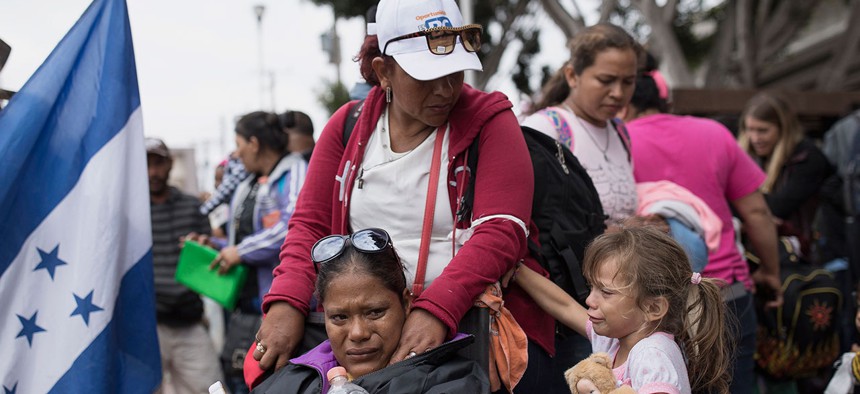
Members of a Central American family traveling with a caravan of migrants prepare to cross the border and apply for asylum in the United States in Tijuana in April. Hans-Maximo Musielik/AP
The Legal Logic Behind Trump’s Decision To Separate Immigrant Children From Parents
The administration is not allowed to indefinitely detain families, so it’s separating the children from the adults.
The Trump administration said this week it’s prosecuting every immigrant caught entering the U.S. illegally, a policy that will likely result in the separation of children from their parents while their legal cases unfurl.
Critics have denounced it as a particularly cruel and mean-spirited tactic. It appears to be motivated by a coldly-calculated strategy to bypass legal protections for immigrant families and unaccompanied children.
Donald Trump is fixated on ending “catch-and-release” polices. Under them, apprehended immigrants who have a right to be heard in court, such as asylum seekers, are let go pending a resolution of their cases. The president believes that allowing people who illegally cross the border to go free will encourage others to follow. His goal, then, is to hold those immigrants in detention.
But the administration is not allowed to indefinitely detain families and children—a group of immigrants that has been growing. So it’s separating the children from the adults.
It’s the latest example of the lengths the Trump administration is willing to go to in order to deter immigrants. U.S. authorities have long viewed detention as a way to send a message to would-be border crossers: Don’t come.
Trump’s deterrence determination, however, stands out in its thoroughness. For example, during the Obama administration there were some scattered cases of family separation, often driven by local decisions, says Katharina Obser, senior policy advisor for migrant rights at the Women’s Refugee Commission, a non-profit advocacy group. Trump “has formalized into policy what is just a cruel and inhumane practice.”
“This represents a new era in the kinds of deterrence measures,” she adds.
The Trump policies also differ in that they comes in the absence of a dramatic increase in immigration. While there has been an uptick in the number of families and children apprehended at the border, apprehensions overall remain historically low.
During the Reagan years, immigration authorities started building up the U.S.’s detention capabilities in response to a wave of Central Americans fleeing civil war. Several decades later, the Obama administration handled an influx of families from that same region by putting them in detention facilities.
Those practices were challenged in court by immigrant advocates, resulting in the protections that Trump is now trying to skirt. Under the settlement of one of those lawsuits, Flores v. Meese, it says the government should avoid detaining minors and release them to their parents whenever possible.
In 2015, a federal court ruled in another case that deterrence is not a valid reason to detain immigrant families and children seeking asylum. That same argument holds true in the case of Trump’s new prosecution policy, says Eunice Lee, co-legal director at UC Hastings College of Law’s Center for Gender and Refugee Studies. On top of that, the practice violates asylum seekers’ right under the Constitution’s due process clause that prohibits the government from taking young children away from their parents. (The American Civil Liberties Union has already filed a lawsuit making those arguments.)
The Trump administration has at different times provided varying reasons for wanting to separate families, a policy it had been mulling for months. Back in March 2017, then Homeland Security secretary John Kelly said the purpose was to deter Central American families from making the dangerous trip to the U.S.; more recently he suggested the reason to dissuade them from coming is that they are poorly educated and wouldn’t assimilate well into the U.S.
During a Congressional hearing last month, Secretary Kirstjen Nielsen said that her agency has separated children from parents to verify that they are indeed related. But this week, she said the practice is part of enforcing the country’s laws. This is what she told NPR:
That’s no different than what we do every day in every part of the United States when an adult of a family commits a crime. If you as a parent break into a house, you will be incarcerated by police and thereby separated from your family. We’re doing the same thing at the border.
Immigrant advocates say that asylum seekers—as many of the Central American immigrants claim to be—are different from criminals; they have a right to come to the U.S. to request asylum.
“By and large these families are seeking protection,” says Lee. “Punishing them by separating parents and their children is really repugnant under domestic and international law.”
As with other deterrence policies before it, the matter will likely be settled in court.






